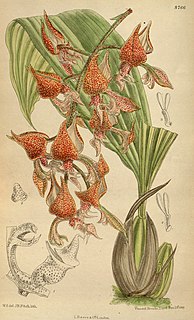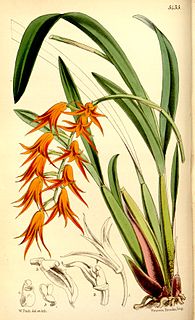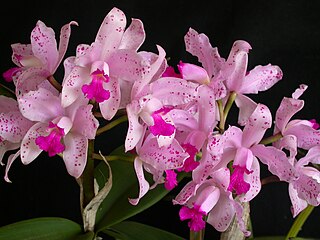
Restrepia, abbreviated Rstp in horticultural trade, is a small genus of 49 orchids in the orchid family (Orchidaceae), closely related to Pleurothallis. Named in honor of Don Jose Restrepo, it tends to be more showy than most other Pleurothallids. They are found primarily at higher altitudes in the cool, damp montane forests of the Andes and Venezuela, with some into Central America up to southern Mexico.

Restrepia antennifera, the antennae-carrying restrepia, is an epiphytic, miniature species of orchid found at higher altitudes in cool, moist montane forests in Venezuela, Colombia and Ecuador.

Brassavola is a genus of 21 orchids. They were named in 1813 by the Scottish botanist Robert Brown. The name comes from the Italian nobleman and physician Antonio Musa Brassavola. This genus is abbreviated B. in trade journals.

Phragmipedium is a genus of the Orchid family (Orchidaceae) and the only genus comprised in the tribe Phragmipedieae and subtribe Phragmipediinae. The name of the genus is derived from the Greek phragma, which means "division", and pedium, which means "slipper". It is abbreviated 'Phrag' in trade journals.

Gongora, abbreviated Gga in horticultural trade, is a member of the orchid family (Orchidaceae). It consists of 65 species known from Central America, Trinidad, and tropical South America, with most species found in Colombia. They grow in wide geographical range from wet forests at sea level to mountainous regions in the Andes, as high as 1,800 m.

Oncidium, abbreviated as Onc. in the horticultural trade, is a genus that contains about 330 species of orchids from the subtribe Oncidiinae of the orchid family (Orchidaceae). As presently conceived, it is distributed across much of South America, Central America, Mexico and the West Indies, with one species (O. ensatum) extending into Florida. Common names for plants in this genus include dancing-lady orchid and golden shower orchid.

Laelia is a small genus of 25 species in the orchid family (Orchidaceae). Laelia species are found in areas of subtropical or temperate climate in Central and South America, but mostly in Mexico. Laelia is abbreviated L. in the horticultural trade.

Anguloa, commonly known as tulip orchids, is a small orchid genus closely related to Lycaste. Its abbreviation in horticulture is Ang. This genus was described by José Antonio Pavón and Hipólito Ruiz López in 1798. They named it in honor of Francisco de Angulo, Director-General of Mines of Peru.

Ada, abbreviated as Ada in horticultural trade, is a genus of 16 species in the orchid family (Orchidaceae), subfamily Epidendroideae, tribe Cymbidieae, subtribe Oncidiinae, alliance Oncidium. The type species is Ada aurantiaca.

Encyclia is a genus of orchids. The genus name comes from Greek enkykleomai, referring to the lateral lobes of the lip which encircle the column. It is abbreviated as E. in the horticultural trade.

Cattleya amethystoglossa is a bifoliate species of orchid from the genus Cattleya.

Brassavola flagellaris is a species of epiphytic orchid of the Cattleya alliance. It grows wild in eastern Brazil, where it fills the evening air with the citrus-like fragrance of its blossoms.

Cattleya maxima is a species of orchid in subfamily Epidendroideae found from Venezuela to Peru.

Encyclia adenocaula is a species of epiphytic orchid of light purple flowers, native to forests in Mexico.

Phragmipedium besseae is a species of orchid in the genus Phragmipedium. It is a terrestrial plant native to the wet montane forests on the eastern slope of the Andes in Colombia, Ecuador, and Peru.

Isabelia is an orchid genus formed by three tiny species and one natural hybrid, spread from the Northeast of Brazil to Argentina, which are closely related to the genus Constantia. During more than a century Isabelia was a genus formed by just one species, however, around 1968, it was merged with genus Neolauchea, also unispecific. In 2001, a third genus was added to it, Sophronitella.

Epidendrum sophronitisLinden & Rchb.f. (1857) is a small Epidendrum orchid that bears a superficial resemblance to a Sophronitis, as the generic epithet was used prior to the year 2000.
Epidendrum parvilabre is a sympodial terrestrial orchid native to the mountainous (~2 km) tropical rainforests of Ecuador and Piura, Peru.

Cattleya rex is a species of epiphytic orchid of showy white flowers, native to montane forests in Peru and Bolivia.

Encyclia candollei is a species of epiphytic orchid of yellow-brown to reddish flowers, native to Belize, Guatemala and Mexico.



















